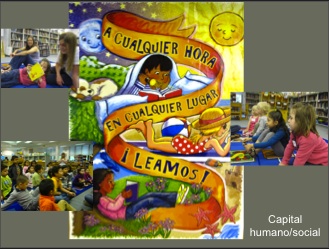Joan Clifford, Lecturer, Romance Languages
Joan Clifford was one of fourteen faculty and one graduate student who participated in a Spring 2010 CIT Fellowship for language faculty interested in exploring with colleagues the most effective and most efficient ways to increase students’ oral production in the target language, in order to increase students’ language learning.
Spanish 106CS “Issues of Education and Immigration” is a fifth semester advanced language course with a requirement of 20 hours of service in the local community. The service projects are connected with tutoring at a dual immersion elementary school or a bilingual storytelling hour for Latina mothers and children.
Joan Clifford, Assistant Director of the Spanish Language Program, teaches Spanish 106CS and wanted to design a final course project requiring students to synthesize the course material with their service experience, while reflecting on the course’s multiple curricular goals. Developing such a project was multi-step process that incorporated feedback from many sources. As a CIT Faculty Fellow, Clifford worked with colleagues in the Spanish Language Program (SLP), Center for Instructional Technology (CIT) staff, and peers in other departments to design the project, select appropriate learning technologies, and develop assessments to ensure the project met the designated learning goals for the course.
The ideal final project needed to focus on language production, synthesis of course themes, reflection on service experiences, and discussion of personal growth. The examples below show the current Multimedia Project, which was interesting but did not maximize these objectives.
Clifford wanted to understand student attitudes about technology and get their input about components to evaluate in the oral presentations. To do this she created a pre- and post-survey for students. She found that students were comfortable with many basic technologies like PowerPoint, mp3 devices, scanning images to digital format, and downloading materials online. Other technologies like flip cameras and editing software were less comfortable for students initially, but after use for the project, student increased their level of comfort and expertise.
Students used a rubric (below) to evaluate other student presentations holistically, and to provide comments:
Evaluation of the Multimedia Project of ____________________
Evaluator (you may leave this blank) ______________________________
The evaluation is based on:
- Time management, organization, rythym, etc.
- Comprehensibility: use of language, vocabulary, pronunciation, etc.
- Development of content relevant to the course: interesting materials, variety of examples, etc.
- Takes into account the audience: visual contact, body language, etc.
Comments/Suggestions:
Evaluation 1 2 3 4 5 6 7 8 9 10
After the Multimedia Project, Clifford surveyed students about the aspects of the presentation they felt were most important. While spoken language skills, content development, and project organization were highly valued, students also placed a great deal of importance on the visual components of their oral presentations. Overall students felt that the visual component should have a similar weight in the grade to language and content. Since this was not the initial focus of the presentation, Clifford decided that supportive activities should be built into the curriculum to assist students with improving their visual presentation, but at the same time the project should be adjusted to put less emphasis on the “glitz” and refocus the students on the presentation content, particularly the critical reflection desired.
After review and evaluation, the format for the new final project is for students to create and exhibit a portfolio of their service learning experience using PowerPoint, Audacity, scanning, audio files, and other relevant technologies. It is important that the new project showcases the students’ critical reflection skills and promotes interaction with the audience to encourage robust conversation. The proposed new design for a portfolio exhibition would include an appointed day at the end of the semester in which students exhibit their portfolios to the rest of their classmates and invited guests. A portion of the class would present their portfolios at a specific station for 20 minutes. The other students circulate between stations and interact, in Spanish, with the presenter to discuss his/her selection of materials for the portfolio. After the set amount of time, students rotate to change presenters. This design necessitates interaction with classmates and pushes students to engage at a critical reflection level.
Through this fellowship Clifford re-designed the final project format so that her students would reflect on their course experiences and interact with their peers, and she plans to implement this format in all other Spanish service learning courses beginning in fall 2010. In addition, she created methods to gather data to increase the effectiveness of the final project for future semesters.


